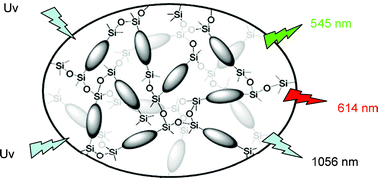This work focuses on the synthesis of a series of chemically bonded lanthanide/inorganic/organic hybrid materials (CE-15-Si-Ln, CE-16-Si-Ln, CE-18-Si-Ln) containing a novel aza-crown ether organic component. The materials show red emission (Ln = Eu), green emission (Ln = Tb) and near-infrared (NIR) luminescence (Ln = Nd). Three functional molecular precursors (denoted as CE-15-Si, CE-16-Si, CE-18-Si) have been synthesized with two or three N-substituted pendant arms containing chelating groups which can not only fulfill the high coordination numbers of Ln3+ ions but also form an inorganic Si–O–Si network with tetraethoxysilane (TEOS). The resulting amorphous materials exhibit regular uniform microstructures for the organic and the inorganic components which are covalently linked through Si–O bonds via a self-assembly process. These hybrids present strong luminescent intensities in red, green and NIR ranges by embedding selected Ln3+ ions into the hybrid system, which may lead to potential applications in organic electroluminescence displays, light emitting devices, functional membranes or chemical/biomedical sensors.

You have access to this article
 Please wait while we load your content...
Something went wrong. Try again?
Please wait while we load your content...
Something went wrong. Try again?


 Please wait while we load your content...
Please wait while we load your content...